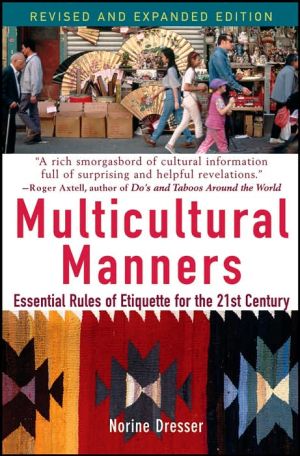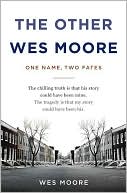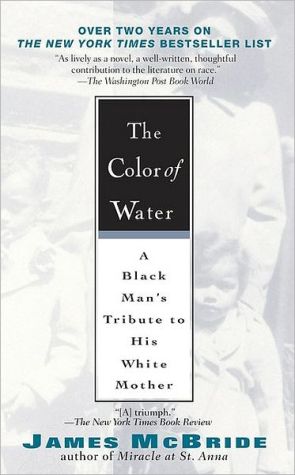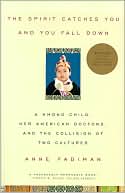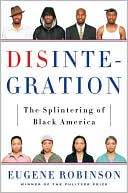Multicultural Manners: Essential Rules of Etiquette for the 21st Century
Both highly informative and entertaining, Multicultural Manners gives readers the understanding they need, the perfect words to say, and the correct behavior to use in a wide range of cross-cultural situations. This incisive and award-winning guide to etiquette features completely updated etiquette guidelines with special emphasis on post–September 11 culture clashes as well as a brand-new section that demystifies unfamiliar cultures in the news. Norine Dresser identifies key cross-cultural...
Search in google:
Your friend's mother-in-law is visiting from Korea. When greeting her, do you bow, shake hands, or kiss her on both cheeks?The meeting with his international customers is going well for the corporate president—until he gives the thumbs-up sign. Why?You welcome your new neighbors with a bouquet of your prizewinning daffodils. Yet your beautiful yellow blossoms are met with looks of shock and horror. Why?Discover the answers in this incisive, award-winning guide to etiquette, now thoroughly revised to reflect today's truly multicultural society. Both highly informative and entertaining, Multicultural Manners gives you the understanding you need, the perfect words to say, and the correct behavior to use in a wide range of cross-cultural situations. The book features completely updated etiquette guidelines with special emphasis on post–September 11 culture clashes as well as a brand-new section that demystifies unfamiliar cultures in the news. Norine Dresser identifies key cross-cultural hot spots and suggests methods that foster respect for diversity. You'll discover:The dos and don'ts of successful business and social interaction with people from different culturesAppropriate etiquette regarding body language, food, child rearing, clothing, word choices, colors, entertaining, romance, and gift givingDetailed tips on avoiding embarrassment at work, in the classroom, in health care settings, on business trips, at meals, at weddings, at funerals, and on vacations and holidaysAmusing firsthand accounts of cultural gaffes that illustrate how miscues happen—and how to avoid themA breakdown of customs, religions, languages, and ethnicities for seventy different countries
Multicultural Manners\ \ By Norine Dresser \ John Wiley & Sons\ ISBN: 0-471-68428-7 \ \ \ Chapter One\ Child-Rearing Practices\ Lazy New Mom\ Evelyn resents it when her Filipina daughter-in-law, Zen, has a baby and assumes that everyone should wait on her, especially Evelyn. Zen expects Evelyn to bathe and change the baby, clean the house, and prepare all meals. Despite adoring her first grandchild, Evelyn is offended.\ Evelyn was unaware that her daughter-in-law was observing common Asian postpartum behavior: the new mom goes to bed for a month while everyone pampers her. Family members, and sometimes neighbors, take over cooking and cleaning; when the baby needs to be fed, they bring a freshly changed infant to the mother.\ In China, this practice is called zuo yuezi (sitting through the month). The woman must stay in bed behind closed windows, cover her head, and take many precautions to insure that she not damage her ability to produce breast milk.\ Once Evelyn discovered that her daughter-in-law was behaving in a customary postpartum manner, she relaxed her attitude.\ Sometimes what we perceive as negative behavior has roots in another paradigm.\ Other cultures give more physical support to new mothers, where family and friends assume household obligations so that the new mom can rebuild her strength for at least one month after delivery.\ Sharing the Bed\ Working mom Jeanne has a surprise when she leaves her ten-week-old son Zachary withthe Mexican babysitter, who lives with her husband, children, and parents. The family falls in love with little Zachary and calls him Santo (the holy one).\ Jeanne is Jewish, and even though she realizes that this refers to a saintly child, she knows it is a compliment and she is not offended. In fact, she is touched by the way the entire family loves and fusses over the child. However, one day when she goes to pick up her son, she finds him sleeping in bed with Grandma.\ This upsets Jeanne.\ Nowadays, many middle-class Americans expect to have not only a private bed but a private room for each child. This is in part tied to American notions about independence and individuality. However, in places where space has been a limited resource, children are expected to share beds with family members, just as they did in the early days of this country.\ Many Asian, Middle Eastern, and Latin American families accept bed-sharing matter-of-factly. Sharing of beds demonstrates family closeness. Latinos use a colloquialism, agusto, to describe the coziness felt when snuggling with a relative. To be agusto is to be completely relaxed.\ In the United States, cuddling up with one's parents or grandparents is relegated to special occasions. It gives children safe harbor and feelings of comfort. Nonetheless, no one expects to see their own children cuddling up with someone else's family members. This was a foreign concept for Jeanne-but one she eventually got used to because of all the love showered upon Santo.\ Joni, another American mother, had a similar start when she discovered that her thirteen-year-old daughter who had gone to spend the night with a Filipino friend had shared the bed with both the girlfriend and the girlfriend's grandmother. In that household, it was not a matter of limited space, but rather a preferred sleeping arrangement.\ People from Latin American, Asian, and Middle Eastern cultures often share sleeping space with family members.\ As children become closer with friends from other cultures, they will experience new customs that they may easily adopt but that may be difficult for parents to accept.\ Breast Milk (See also: Hot/Cold, p. 87.)\ The community health clinic treats mothers from mostly Latino backgrounds. The clinic hires Andrea as their lactation consultant to encourage the women to breast-feed their babies and to hold classes to provide appropriate information.\ Andrea knows that the women have never received formal instruction about breast-feeding and have misconceptions about the process. At the first class meeting, she asks what they already know about breast-feeding. The first woman responds, "If someone hits you on the back, it will spoil your milk."\ Andrea is dumbfounded.\ The women shared their other beliefs:\ If your milk spills on the floor, none of it will be any good. If you get upset or angry, you will spoil your milk. After a year, it's bad for babies to breast-feed because the milk is no good. Smoking, drinking, or taking medication doesn't affect the baby. Formula is as good as breast milk. If you eat beans, the baby will get too much mucous. If you don't cover your back, all the milk will dry up. Beans or chiles will ruin the taste of the milk. None of these beliefs is true, and Andrea had a difficult time reeducating the mothers. To add to the misconceptions, many new Latina moms believe the colostrum (the first fluid secreted after birth) is unclean. Accordingly, they do not breast-feed their babies until the third day when the true milk arrives. This is unfortunate because the colostrum contains vital immunity-building substances for the newborn.\ Andrea discovered an additional negative attitude about breastfeeding. Immigrant mothers from a variety of backgrounds think it is more American and more modern, and thus more desirable, to bottle-feed their babies. They needlessly spend money on formula, a commodity that cannot match the quality of milk they naturally produce. Breast milk won't cause intestinal infections because it is pure. In addition, it is always at the proper temperature, and it costs nothing.\ Many immigrant mothers have misconceptions about breastfeeding. Younger Cambodian, Chinese, and Vietnamese women are more reluctant about breast-feeding than older women.\ Lactation education is important for immigrant mothers, particularly those who are away from their own mothers, who would ordinarily provide breast-feeding encouragement.\ Independence\ Robert and Greta Lyons are a very friendly couple, so when they meet eighteen-year-old Paulino from Colombia, South America, they invite him to live with them until he gets settled here. After a short time, Paulino tells them he would like to go to school and look for a job to pay for his school expenses. He asks his new friends if it would be all right if he continues to live with them.\ Robert and Greta say yes, but they ask him how he will cover his living expenses. Paulino is shocked. He becomes cold and silent.\ Where Paulino grew up, one offers a friend or relative a helping hand with no questions asked and no strings attached. That's the Colombian way. Colombian hosts would never expect their guests to pay for their own expenses.\ While at first Paulino resented their questions, his hosts finally convinced him that the request for money was not a negative commentary on how they felt about him. They explained that they would request the same of their own children who remained at home past the age of eighteen. Paulino eventually accepted their point of view. He cheerfully contributed toward his living costs and felt like a full member of the Lyons family.\ When they are old enough to work, children from other ethnic groups contribute to household expenses; however, parents do not charge for their offspring's living costs. Rather, children give a portion of their earnings to help the family. The difference is semantics and attitude.\ American attitudes regarding an offspring's independence and responsibility may be misinterpreted as being stingy and unloving.\ Chaperone (See also: Home Alone Together, p. 149.)\ Two girls from different Latin American countries meet in an American high school. Luisa was born in Costa Rica but raised in the Dominican Republic, while Viviana is from Ecuador. The girls agree to see a movie together on Saturday night. After Luisa arrives at Viviana's door that night, Viviana's mother answers and looks at the girl strangely.\ Luisa steps into the house while the mother leaves to notify her daughter of Luisa's arrival. Fifteen minutes pass before Viviana comes into the room, her eyes red from crying. Viviana explains that she won't be able to go out. She tells Luisa she will see her at school on Monday, but, in fact, their friendship ends that night.\ In Ecuador, girls between the ages of sixteen and twenty don't go out unaccompanied. If they do, people assume them to be loose women. In giving permission for her daughter to go to the movies, Viviana's mother assumed that Luisa would be bringing along her family. In Ecuador, that would have been the only acceptable way that a respectable girl could go out. If Viviana's mother had allowed her daughter to go out without a chaperone, even in this country, her reputation would have been ruined. She could not undertake such a risk.\ On the other hand, even though Luisa also came from a Latin American culture, the customs were different, and no stigma was attached to her going out without a chaperone. That is why the reaction of Viviana's mother caught her off-guard.\ Latin American cultures are complex. Although they share a language, they have a wide diversity of customs, such as child-rearing practices.\ Coining (See also: Alternative Healers, p. 107.)\ One day as Mr. Hart walks from desk to desk in his sixth-grade class, he notices strange-looking red marks on Jenny Truong's neck and forehead. Alarmed, he informs her that she needs to be seen by a doctor right away.\ Without giving her a chance to explain, he notifies the principal that Jenny is a probable victim of child abuse. In spite of Jenny's protests, the teacher and the principal notify the authorities and accuse Jenny's father of physically abusing his child.\ People from a number of different Asian countries believe that internal bad winds cause illness. However, by bringing the wind to the surface, the illness can leave and the person will be healed. The home remedy for making the wind or illness leave the body is called "scratch the wind" or "coining."\ When a person has a backache, cold, upper respiratory problem, or headache, the symptoms are alleviated by rubbing a coin rigorously against the back, neck, or forehead. In the United States, Asian immigrants first dip the coin into an oil or mentholatum. Then they rub very hard with the coin until the skin turns red. Unfortunately, the resulting red marks have frequently been misinterpreted by school officials who are vigilant about indications of child abuse.\ After contacting Jenny's parents, who spoke only Vietnamese, the school officials found a translator who convinced authorities that Jenny was not a victim of child abuse, but rather a recipient of a folk remedy. Although school officials eventually accepted this explanation, they warned that the next time Jenny was sick she should see a doctor.\ Coining is similar in concept to the old-fashioned American mustard plaster, which when placed on the chest becomes hot, breaking up respiratory congestion. It is also related to the Middle Eastern and Mediterranean practice of cupping, in which heated inverted cups are placed on the patient's back to create a suction to draw the "poison" to the surface. These different home treatments share a similar belief: if the source of the physical problem is brought to the surface, it can escape, and the patient will recover.\ Officials have also been called in erroneously as a result of suspicion about other skin marks called las manchas Mogolica (Mongolian spots). These are bluish-gray or purple birthmarks that most often appear at the base of the spine of Asians, Native Americans, Latinos with Native American ancestry, and some people of Mediterranean background. Children are born with them, and they usually fade in time. They are not the result of parental abuse.\ Unfortunately, one day-care worker in California assumed these Mongolian spots were signs of mistreatment on a Latino preschooler. Consequently, the child was placed in foster care for two weeks because California enforces mandatory reporting of child-abuse suspicions. The traumatized child was finally released to her parents.\ An immigrant child's bruises don't always mean child abuse. On the other hand, teachers should not be too quick to dismiss them as merely folk-medicine treatments.\ School workers and others should double-check with culturally aware consultants regarding suspicious marks and potential signs of abuse.\ (Continues...)\ \ \ \ \ Excerpted from Multicultural Manners by Norine Dresser Excerpted by permission.\ All rights reserved. No part of this excerpt may be reproduced or reprinted without permission in writing from the publisher.\ Excerpts are provided by Dial-A-Book Inc. solely for the personal use of visitors to this web site. \ \
1The new rules of communicationBody language11Child-rearing practices29Classroom behavior37Clothing and jewelry51Colors63Foodways71Gifts91Health practices101Holidays115Luck and supernatural forces123Male/female relations and gender issues141Miscellany151Prejudice167Time177Verbal expressions1832Clearing cultural confusionsAfricans204Asians216South Asians220Southeast Asians226The Balkans233Independent members of the former USSR238Middle Easterners249
